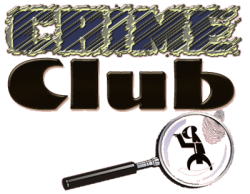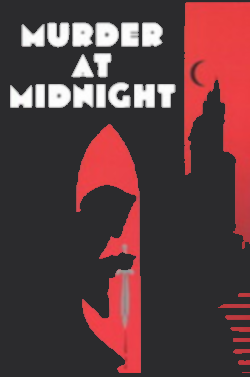The Crime Club:
“The Sun Is a Witness”
(04/03/47 ).
***
NBC Short Story :
“The Lottery”
(03/14/51).
**
Alien Worlds:
Seeds Of Time
(4/8/79).
***
Murder at Midnight:
“Island Of The Dead”
(12/20/46).
Right Click here to download

Produced and directed by Willis Cooper (Lights Out, Quiet Please) The Crime Club was a series that ran in 1946 and 1947, featuring murder and mystery stories.
The radio series opens as a phone rings and a voice answers, “Hello, I hope I haven’t kept you waiting. Yes, this is the Crime Club. I’m the Librarian…” (Actually it’s Raymond Johnson (best known as the host of Inner Sanctum).
Although there exists no evidence of a contractual arrangement between the Mutual Network and Doubleday publishing even a casual exploration of the titles in this series makes it clear that the inspiration for the series has to be the literary imprint, The Crime Club. As most of the stories told were adaptations from this Doubleday series.
This imprint of books began in 1928 with the publication of The Desert Moon Mystery by Kay Cleaver Strahan (creator of one of the first female fictional detectives).
The imprint continued to publish until 1991.

From April 3rd of 1947 by way of the Mutual network. We have, “The Sun Is A Witness”.
Aaron Marc Stein (1906-1985), provided the novel of the same name (published in 1940) from which this radio play is adapted. Stein who specialized in mystery fiction enjoyed considerable success with many of his works being translated into German, French, and Spanish.
In this story an old man and his fortune are the subject of interest and, in the end, a motivation for murder. A murder and murder who are undone by shadows on a roll of film.
This program stars, Raymond Edward Johnson, Sidney Smith, Stedman Coles (adaptor), Roger Bower (producer, director).
This is a pretty good story, mostly quite well presented and reasonably well acted. It moves right along, but unfortunately, as often happens with attempts to adapt a full-length novel to a 25 or 26 min. format for radio shortcuts were taken. And I at least, end up not entirely satisfied with the pacing. The ending in particular feels rushed.

NBC Short Story – The Lottery (03/14/51).
N.B.C Short Story was not a commercial success lasting as it did only one season in 1951..
That’s a hell of a way to start an introduction isn’t it? Well it is true. But then, we all know that commercial success and artistic success do not necessarily ride the same horse. That was certainly the case with this series.
One thing this series does do is to provide evidence of how compatible the short story and the half hour anthology format so common in radio was . Utilizing as it did the short stories of many of the best writers of the era, Hemingway, Steinbeck, Faulkner, many others.

Very high on any list of suspense/horror writers would be Shirley Jackson. This is her timeless short story, “The Lottery”. A justifiably famous story that takes place in a small town Probably one not unlike Bennington, Vermont, where Jackson lived and worked.
The strength of this story lies in Jackson’s ability to expose the unexamined evil in everyday life that goes right down to the root of human nature itself. There is a well produced reading of the short story provided by the New Yorker magazine available Here.

Alien Worlds – Seeds Of Time (4/8/79)
Alien Worlds was an American syndicated radio show that produced 26 episodes in 1979 beginning on January 7th. With its excellent soundtrack and production standards The successful series eventually would play on over 500 radio stations all over the country. Between 1979 and 1980 the series found even more success internationally lottery justifiably famous story after it was picked up in New Zealand and Australia.
The stories involve the governing body for the development and exploration of space, the I.S.A. (International Space Authority). Organized by all earth nations, the ISA advances the interests of humans in interstellar space. Their base is officially named “The Arthur C. Clarke Astronomical Observatory” but is mostly referred to as, “Starlab”. From here a small cadre of scientists diplomats and explorers and a computer named after Sherlock’s smarter older brother Mycroft, undertake awesome responsibilities as humanities emissaries to the stars.
Aside from the 26 programs that were broadcast; there were four more produced but never aired.

Returning from a patrol, Capts. Graydon and Griff salvage a metallic space capsule that nearly collides with their ship. Alienologist David Ballin, while examining the capsule alone, is overtaken and transformed into a strange placenta that duplicates his DNA.
Oddly enough this turns out to not be as bad as it would seem.

Is Murder at Midnight – “Island Of The Dead” which first aired on December 20 of 1946.
Produced in New York, Murder At Midnight was heard over the Mutual Network starting on Sept. 16th of 1946 until Sept. 8th of 1947. Produced by radio station WJZ. The show was known to occasionally reproduce scripts that had been performed on Inner Sanctum. This practice allowed the show to feature tales of murder most macabre by some of radio’s top writers without paying top dollar.
The show was filled with tales of death and mayhem, not always at midnight. The show was hosted by Raymond Morgan with his memorable introduction, “… The witching hour, when night is darkest, our fears the strongest, our strength at it’s lowest ebb. Midnight when the graves gape open and Death strikes”.
The cast featured Elspeth Eric, Mercedes McCambridge, Barry Kroeger, Betty Kane, Carl Frank, Barry Hopkins, Lawson Zerbie. Charles Paul played the creepy organ music, and Anton M. Leader directed.
I have grown to love “Murder at Midnight”. Certainly I Know that the show is often silly. But it has cultivated the grace of becoming Camp. The program is far more “Noir” than it’s sister program Inner Sanctum taking as, it does, a more hard-boiled approach to the supernatural.

A man just out of jail after fifteen years, kills those who sent him there…one at a time. The program has a good grisly ending which of course adds to its pleasure for me.
Robert Newman was the writer and Louis G. Cowan produced.
There is a short story from Philip K Dick, “The Eyes Have It”.This story was published in Science Fiction Stories #1 sometime in 1953 (I think this is probably wrong. At least this story is not cited as being among the contents of this collection in the Wikipedia article). It is in public domain and is available here.
We will be going out with a song from Thomas Edison Records recorded in 1901, Silas Leachman’s, Fortune-Telling Man.
This song might be considered racist today as it was performed by a white performer in black-face. On the other hand while the practice of performing in black-face is very much frowned on today. Silas Leachman (1859-1936) was a very popular performer who often performed music composed by black artists who regrettably had few outlets for their creativity. Yet I am uncomfortable in suggesting any positive side to this practice.
However I feel about it, it is also undeniably a historic cultural artifact.
Leave a comment